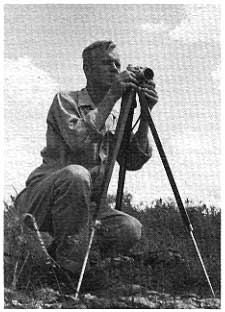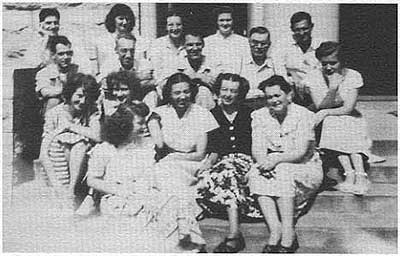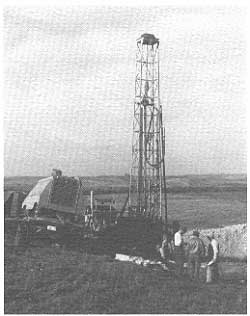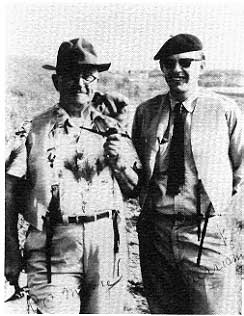Prev Page--R. C. Moore || Next Page--1960s and 1970s
9. Post-World War II
World War II touched all of Kansas. By 1945 and the end of the war, nearly every community in the state, no matter how small or remote, had sent someone to the war--some 215,000 Kansans were in uniform during World War II, and 3,500 were killed in action. Several Kansas towns became homes to newly built airfields--huge landing strips that were training bases for pilots before they were shipped overseas. The larger cities, such as Wichita and Kansas City, experienced manufacturing booms, especially related to aircraft. Commodity prices increased and improved the income of those who stayed home.
Like the rest of the state, the Kansas Survey was directly affected by World War II. The war, for example, altered the Survey's direction, focusing its efforts more on resource production--not only on coal, as during World War I, but also on oil and gas, water, and other resources. Concomitantly, the war increased the Survey's budgets, to more than $80,000 per year during a couple of the war years, far beyond anything it had experienced before in its history (Schoewe, 1965, p. 69). The war brought other minor, though perhaps more noticeable, changes. The Survey shared building space with officers who were at the University for training (Griffin, 1974, p. 486). Survey personnel found their field work sometimes curtailed by the lack of gasoline and rubber for tires. And a growing number of staff members were gone from the Survey in military service.
But the war finally ended, and the ensuing times were good for the Survey, indeed for all of American science. Veterans returned from the war and enrolled in schools in record numbers, providing plenty of work for academic departments and everyone connected with them. What's more, the economic boom continued, providing jobs and, perhaps of more interest to the Survey, encouraging oil and gas exploration at a pace that peaked in the early 1950s. The years during World War II and shortly thereafter, from around 1940 into the 1950s, were again a time of transitions at the Survey. Some of those transitions were slow, some were abrupt, some were more apparent than real, and others were perhaps more difficult than was immediately apparent.
Publication
Those changes began most visibly with the start of the war. One measure of change was the pace of publication. Until about 1940, the Survey produced publications at a languid rate of about one a year. Suddenly, in 1940, the Survey issued nine books, followed a year later by a bulletin that had 13 parts. Some of the publications were related directly to the war effort. In 1942, for example, the Survey published two reports on ground-water availability related to national defense (Lohman, 1942, and Lohman and others, 1942) and another book called Kansas Mineral Resources for Wartime Industries (Jewett and Schoewe, 1942). Moore enlisted the entire Survey in the war.
"Kansas possesses a wealth of necessary materials for building the strength of our nation in time of war, when defense of the American way of life becomes the paramount duty and privilege of all Americans. It is very desirable to take stock of every substance at our command and every aspect of utilizing each one of them that pertains to preserving our lives and liberties." (Moore, in Jewett and Schoewe, 1942, p. 73)
Moore wasn't thinking only of the war, but also of the time when the war would be over.
"The importance of the Kansas region in mineral resources, combined with advantages of its central inland geographic location, and facilities for transportation, has already led to establishment of several great war industry plants in this area. Modification of these for peace-time pursuits will be made very readily and naturally in the case of some of these plants but less easily in the case of others. At all events, the present developments are in line with a very sound program of industrial growth that should lead to a well balanced economy of agriculture and industry of various sorts based on mineral and agricultural resources." (Moore, in Jewett and Schoewe, 1942, p. 74)
That increased pace of publication continued through the war, through the late 1940s, and well into the 1950s. Nearly all of those works fall into three groups: oil and gas, water, and paleontology. The oil and gas work was as specific as a report on oil and gas in Montgomery County and as general as a description of exploration in western Kansas. The authors included old hands like Wallace Lee, John Mark Jewett, and W. A. Ver Wiebe. Water was the subject of a number of county reports, which now focused on geology and ground water. Much of the work was undertaken in cooperation with the U.S. Geological Survey and was done by John Frye, Bruce Latta, Thad McLaughlin, and others. The paleontology consisted of a continuation of some of Moore's work, along with contributions by Frye and Claude Hibbard. By comparison with the Survey's other efforts during the war years, the work in paleontology seems oddly esoteric. Indeed, during those years the Survey's work--with the exception of paleontology--was clearly related to the development of natural resources: not only oil and ground water, but coal and metallic minerals (interestingly enough, the Survey's first geophysics-related publication [Jakosky, Dreyer, and Wilson, 1942], also appeared during this period. It described magnetic, gravity, and resistivity studies in the Tri-state mining district).
John C. Frye
The war was the primary, but not the only, impetus for change in Survey research directions in the 1940s. Much of the responsibility also belonged to John Frye. A native of Ohio who had a Ph.D. from Iowa, Frye came to the Survey in 1942 as a replacement for Kenneth Landes, who had served as the Survey's assistant director since 1937 (for background on Frye, see Willman, 1983). Landes had claimed a role from Moore in the late 1930s as the day-to-day administrator of the Survey, handling administrative details by himself; important decisions generally involved both Moore and Landes. Frye began in much the same role, and then carried it even farther. With Moore gone from the Survey from 1943 to 1945 on assignment to the Army, Frye was in charge of the organization. Even the major decisions were his. In 1945, his title became executive director. While he directed the Survey, Frye continued to publish in his specialty, Pleistocene geology, probably reflecting his interest in the Pleistocene's role in water production. He also wrote a number of county reports, nearly all of which, such as those on Meade and Thomas counties, were locations where the surface geology was dominated by the Pleistocene. And he surrounded himself with staff members, such as Ada Swineford and A. Byron Leonard, who contributed significantly to his studies of the Pleistocene. In fact, Frye and Leonard published a volume on the Kansas Pleistocene that became the classic reference on the subject (Frye and Leonard, 1952).
Pleistocene geology was not the only new area of emphasis for the Survey. Beginning in the late 1940s, Norman Plummer published articles related to the resources that could be manufactured from Kansas clay. Through basic research on the presence and nature of clays in the state (see, for example, Plummer and Romary, 1947), Plummer encouraged the ceramics industry in the state, which started with brick and tile manufacture and continues to be a major Kansas industry today. The work in ceramics and Pleistocene geology, however, was hardly done at the exclusion of other efforts. The Survey continued to churn out county reports on geology and ground water, updates on oil and gas developments, and occasional volumes on the application of geophysics. It also produced standard references in stratigraphy, including, in 1951, a book describing the Kansas rock column (Moore and others, 1951), and, three years later, what became a standard reference on the oil and gas fields of eastern Kansas (Jewett, 1954).
In the fall of 1951, Moore took a sabbatical leave to serve as a visiting professor at the National University of the Netherlands. While he was gone, the KU geology department changed its chairman; Moore returned, in 1952, to take the job of chair for the third time in his career (it is possible, in describing the history of the Geological Survey, to understate its interaction with the KU geology department. For many years, the two shared the same quarters and were all but identical. Many of the staff were listed as members of both, and the Survey directors wrote official documents under KU geology department letterhead almost as often as they used Survey stationery. Moore chaired the department from 1920 to 1939, again from 1940 to 1941, and the final time from 1952 to 1954 [see Dunbar, p. 5, in Teichert and Yochelson, 1967]. With the expansion of Survey staff in the late 1940s and early 1950s, and especially once the Survey moved from Lindley Hall to a separate building on KU's west campus, it is far easier to differentiate the activities of the Survey and the department). The geology department was concerned with the demands of rapidly increasing enrollment, much of it related to veterans returning to school on the GI bill. Moore dealt with departmental issues, then, only to see John Frye resign from his executive directorship of the Survey early in 1954.
Frye left to become chief of the Illinois State Geological Survey, where he continued work in the Pleistocene, but expanded his efforts into the fledgling field of environmental geology. By the end of his career at Illinois, he was especially known for his considerable efforts to build bridges between geologists and the public and political officials who needed geologic information to make decisions. Frye retired from the Illinois Survey in 1974, but then became executive director of the Geological Society of America, a Boulder, Colorado-based organization of academic and professional geologists that is one of the two or three most important geological societies in the country. Frye left the GSA in 1982, and died only five months later.
Frye worked at Kansas under the lengthy shadow of R.C. Moore, yet he achieved distinction on his own. Frye published often and Survey staff members of the time, including R.C. Moore, recognized that Frye was in charge of the Kansas Survey. When Frye announced his resignation in 1954 to go to Illinois, KU chancellor Franklin Murphy began a national search for a replacement. Moore clearly felt left out of the process, and wrote Murphy complaining that he (Moore) had been relegated to a "largely forgotten and needless figurehead" (Moore to Murphy, 13 March 1954, Murphy Collection, KU Archives). Moore was still the Survey's director. He was still the state geologist. He was still the person most responsible for creating the Survey of the mid-twentieth century. He was still the single person most closely identified with the organization. But in some respects Moore had already been replaced. For 15 years he had not been involved in the day-to-day administrative details of the Survey. He was far less active in the statewide politicking required by the job. He was absent from KU and the Survey for four years during the period from 1943 to 1953 (in addition to active military service from 1943 to 1945, and the sabbatical for the 1951-52 school year, Moore had served as a consultant to Douglas MacArthur in Japan during 1949 [see Dunbar, in Teichert and Yochelson, 1967]) and part of the time he was occupied by the KU geology department. As far as the Survey was concerned, the transition from Moore was largely complete. In June 1954, Moore resigned as director and state geologist, though he retained the title of "principal geologist" (Moore to Murphy, 29 June 1954, Murphy Collection, KU Archives) and concentrated most of the remainder of his career on research, publication, and professional societies and their activities.
From Moore and Frye to Foley
In some transitions, there is an heir apparent. But not with Frye's departure from the Kansas Survey. KU chancellor Franklin Murphy picked, ironically enough, a staff member from the same Illinois Geological Survey that Frye had left to direct. Frank Foley (1906-1985) was a native of Ontario, Canada. Foley had a Ph.D. from Princeton and had previously served as head of the North Dakota Geological Survey, district chief of the U.S. Geological Survey's ground-water branch in Madison, Wisconsin, and, from 1951 until he came to Kansas, head of the ground-water section of the Illinois Survey. R.C. Moore's specialties were paleontology and stratigraphy, and John Frye had pushed the Survey into the Pleistocene, but Frank Foley brought expertise on ground water. Where those previous directors had molded much of the Survey around their particular research interests, Frank Foley did not, or certainly to a lesser extent than Frye and Moore.
Much of the research direction of the Survey that Foley took on was determined by the background and talents of the staff. The ground-water portion of that staff was still part of a cooperative effort with the U.S. Geological Survey, and although the ground-water section comprised nine staff members, it was only one part of a large organization. In 1954, the Survey was organized into several major sections, including Basic Geology, Publications and Records, and Mineral Resources, which was further broken into oil and gas, subsurface geology, petroleum engineering, ceramics, and geochemistry. The Survey had established a southeastern Kansas field office in Pittsburg in the early 1950s with two staff members. In addition to the ground-water program, the Survey carried on cooperative programs with the USGS in mineral fuels and topographic mapping. That Survey of the mid-1950s already listed a number of staff members who would, over the years, become well-known and closely associated with the Kansas Survey and Kansas geology. John Mark Jewett, A. Byron Leonard, Ada Swineford, and Walter H. Schoewe remained on the staff. In ground-water, Howard O'Connor and Charles Bayne. In ceramics, Plummer, William Hladik, and Ron Hardy. In geochemistry, Russell Runnels. Wallace Lee and Edwin D. Goebel led research related to oil, and added to the staff a young geologist named Dan Merriam. Grace Muilenburg also joined the Survey and became well known for efforts in journalism and geologic education.
Howard O'Connor in a picture taken in the late 1940's. O'Connor focused on Kansas geology and ground water; his career spanned four decades at the Survey.

In sum, the Survey of the early 1950s had accumulated a staff with expertise in basic geology and stratigraphy, oil and gas, ceramics, and ground water. With John Frye's departure and Moore's resignation as director, the emphasis on paleontology had all but disappeared. Geophysics, at least so far as the Survey was concerned, had yet to arrive. As a result of World War II and the boom times that followed, the Survey was more development-oriented than, perhaps, it had been since the days of Erasmus Haworth.
Survey staff members on the steps of Lindley Hall in 1949. Back row, left to right: Jack Koenig, Lila Hagerman Watkins, Betty J. Hagerman, Maxine McClintock, John C. Frye; third row: Russell Runnels, John Mark Jewett, R.K. Smith, Arden Brown, Alta Nichols; second row: Grace Muilenburg, Jo Batchelor, Alice White, Ada Swineford, Bernice McClintock; front row: Bernita Mansfield.

That orientation changed, slowly, under Frank Foley, though it is difficult to say how much of that change was the result of Foley's efforts, how much came from the people who surrounded him, and how much was due to the temper of the times. Certainly there was no drastic increase in the number of ground-water investigations that took place. The Survey did begin cooperative programs with other state agencies that produced regular measurements of water-levels in observation wells in western Kansas, providing the first consistent, baseline quality data on water-levels for western Kansas, information that became particularly important in the 1960s and 1970s when irrigation boomed and water levels dropped. Occasionally the Survey looked at water problems for an entire watershed, for example, and from time to time it did chemical analyses of the ground-water quality, again providing important baseline information. On a statewide level, Foley was involved with the production of a report called Water in Kansas, which appeared in 1955 and included a series of policy recommendations for state water problems. Many of those recommendations resulted from the floods of the early 1950s that devastated much of the Kansas River valley and left water standing in far western Kansas, floods that were soon followed by drought.
The Survey's rotary drill rig in the early 1960's.

However, most of the Survey's efforts in ground water were aimed at a continuation of the county reports that had been done for decades. County reports were important, basic beginning-points in the study of ground-water and geology of the state. For many Kansans, especially in rural parts of the state, counties are the most immediate form of government, and information presented on a countywide basis was particularly relevant to them. Moreover, these new county reports tended to be more quantitatively exact than those of the 1930s and 1940s, probably because the study of ground water was beginning to mature as a science, and Survey research began applying mathematical formulae to help answer questions of water movement underground.
Changing directions
In addition to the standard areas of ground water, oil and gas, ceramics, and stratigraphy, the Survey began moving in other fields. One was geophysics. Dan Merriam, who had been at the Survey since 1953, began working with William Hambleton, a former assistant professor at the KU geology department who joined the Survey in 1956 as its assistant director. Hambleton later began to fill the role for Foley that Ken Landes, first, and John Frye, later, had filled for Raymond C. Moore. Hambleton began to deal with many of the routine administrative details. In the mid- to late-1950s, Merriam and Hambleton began to bring geophysics to bear on a number of problems related to Kansas geology. Before the 1950s, geophysics in Kansas had been limited mainly to the use of seismic lines in oil and gas exploration. The development of instrumentation and new methods for collecting data led to the application of magnetic and gravity studies in limited parts of the state in the 1940s. In the 1950s, Merriam and Hambleton published papers that brought geophysics into the mainstream of Survey research. Together, in 1957, they published a review of geophysics in Kansas (Hambleton and Merriam, 1957), and in 1959, Hambleton edited a book of 25 papers on the use of geophysics in Kansas that summed up the state-of-the-art for contemporary geophysics in Kansas (Hambleton [ed.], 1959). The work with geophysics was the beginning of a 1960s emphasis at the Survey on quantitative approaches to geology, including the application of computers to geologic questions and eventually the use of mathematical geology.
R.C. Moore and D.F. Merriam on a field trip in the late 1950's.

From its location at the University of Kansas in 1889, the Kansas Geological Survey was caught in an essential conflict between the relative roles of geologic research and service to the state. Until the second world war, the two coexisted, more or less peacefully. In the late 1800s and early 1900s, under Erasmus Haworth, the Survey concentrated on research that aided in resource development; its more basic research revolved around paleontology. That same approach continued, although perhaps with a more academic, research orientation, under Raymond C. Moore, who headed the Survey while it produced the basic materials--geologic maps, cross sections, county reports--that were so important to the state. Moore clearly believed in the Survey's service role. He worked to establish a well-sample library and began major ground-water studies, and even flirted with the notion of involving the Survey in oil and gas regulation. But at the same time, Moore continued basic work in paleontology. If the comparative roles of service and research could be gauged during Moore's time, the results would show a new emphasis on research, while exploring avenues of service to the state.
World War II changed all that. The war removed much of the bent toward basic research from the Survey's activities and replaced it with activities that would aid in the exploitation of resources. The gauge of research-versus-service would show clearly, at the end of the war, that the Survey was a service agency, albeit an academic one. With the departure of John Frye and the reduction of efforts in Pleistocene geology, basic work slowed more. Later in the 1950s, the proportion between services and research began to change again somewhat, with paleontological activities replaced by geophysics. The increasing role of geophysics may represent not so much of a trend toward research, as it was the direct application of newly developed technology toward old problems. Until the 1950s, the Survey was made up of people who took the classic field approach to geology. R.C. Moore's students called it "sharpening the mind by dulling the pick." But beginning in the 1950s and coming full force in the 1960s, was the notion that banging on rocks was not the only way to learn about geology. Geophysics may have been just the first expression of that idea, but it was certainly not the only one.
The Survey's use of those alternative tools--first geophysics and later computers--probably was not the result of force of leadership by any one person. In part, it may have been the temper of the times. In the early to mid-1960s, the concept of plate tectonics was slowly accepted, and an emphasis on structural geology came along with it. Studies of structure, especially deep structure, required all sorts of newly available, largely quantitative, tools. Even in Kansas, far from the edge of any continental plate, the shifting paradigm of geology may have had an impact. Perhaps the nucleus of people around Frank Foley--Hambleton, Merriam, later John Davis--was the right critical mass to drive the Survey in a new direction. Whether it was the time or the people or newly available tools and theories, the Survey began changing the proportion of its service and research. Service activities were still the dominant activity at the organization, but research grew, calculated or not.
In some respects, there was no competition between research and service during World War II because there was so little basic research. Also, it is difficult to draw a sharp distinction between service and research. Some Survey activities, such as loaning samples of oil-well cuttings, were clearly services. Others, such as paleontology, were clearly research. But most activities fell somewhere in between, were more difficult to define. Even so, with the gradual reappearance of research activities at the Survey, the jockeying for resources was on. Geophysics, mathematical geology, and computers had replaced paleontology as an area of research emphasis as the Survey faced the second half of the 20th century.
Prev Page--R. C. Moore || Next Page--1960s and 1970s
Kansas Geological Survey, KGS History
Web version February 2003. Original publication date 1989.
Comments to webadmin@kgs.ku.edu
The URL for this page is http://www.kgs.ku.edu/Publications/Bulletins/227/11_post.html